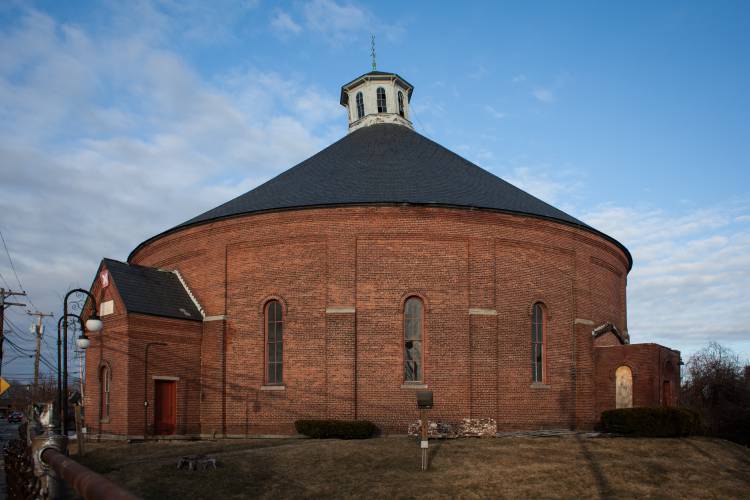(Addendum: There are two problems with this idea. One is that the Concord tank still has all its workings, including the massive cap that floated on the gas. This is what makes it quite possibly unique among the nation’s gasholder buildings, but it would also make it very expensive to turn into a swimming pool. The other problem is pointed out by a comment below: The German tank is steel, while Concord’s is brick. Very different materials, very different capabilities.)
Concord has an old gas holder building, a.k.a. gasometer – a lovely but decaying and expensive-to-fix-up remnant of the days when gas for lights and heat was made by processing coal, then stored on site. The city’s gasometer held 120,000 cubic feet of the stuff under a giant floating cap, but it closed in 1953 when natural gas (known as “rock gas” at the time to differentiate it from coal gas) came to the city. There were other, smaller gasometers around, including one at St. Paul’s School.
There has been debate for years about what to do with the building, which is a lovely round brick structure near the highway. It would cost a couple million bucks to make the building safe and since the owner, Liberty Utilities, has no use for the property they are loathe to spend the money. The building is slowly falling apart and even though it’s on the National Historic Register, its future is uncertain.
Well, here’s an idea: Turn it into a scuba-diving park! That’s what was done at a former gasometer in Germany, as I learned from this video sent to me by my brother.
Remember, you read it here first.



 Return to the Concord Monitor
Return to the Concord Monitor
I don’t know what the cost and trade-offs are but to save an historic building while promoting SCUBA diving sounds like a win-win. Definitely worth more analysis.
The German gasometer is made of STEEL and looks very cool!
Brick water tanks are commonplace in the developing world. Google “brick water tank” for examples. The standard water depth is 1250 mm, or about 4 feet. The maximum recommended water depth for a brick water tank is 2 meters or 6.5 feet. Beyond that depth, a brick wall of any reasonable thickness will simply blow out from water pressure. Brick and mortar is strong in compression, not in tension. The Gas Holder filled with water would need silo hoops on every course of bricks to hold it together.
So the Concord Gas Holder could make a cute kiddie pool, but a scuba tank? Nah, no way.
Should we consider the residual toxic environmental the “rock gas” production likely produced on site. Is this a brownfield and if so what are the impacts to those who may use the site after it is re-purposed as a pool, pub or public place? The lost train station represented a gem while this artifact of the fossil fuel consumption is less of one. Perhaps it’s time to look towards the future, bury the past and put the $ on something for our children and the future. I vote for a street car station to replace it after the brownfield is cleaned up.
Good question – there has been considerable cleanup of the property already; I think it’s pretty clean. But that’s definitely an issue at many of these sites.
As for your point about historical preservation, the B&M trains that used the much-lamented torn-down train station were monuments to dirty fossil-fuel use, first coal and then diesel – just as much as coal-gas was.
The station building was for people who managed the trains, businesses and individuals who traveled and their loved ones. As to movement of people and materials trains are efficient and a source of social capital in public transportation. Our current mode of travel is far less efficient in fossil fuel consumption and pollution. The 1888 station was built to last centuries then torn down less than 3/4 of a century later to build a monument to parking and shopping. The gas building although interesting to look at was for storage of gas, nothing more.